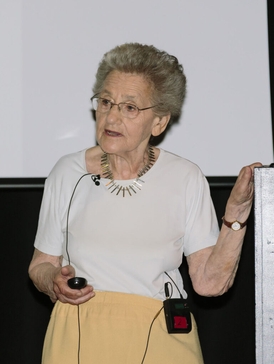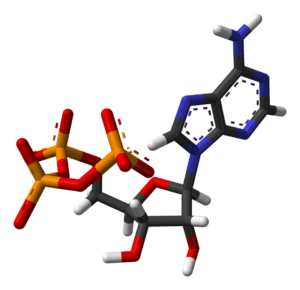Olga Kennard facts for kids
Quick facts for kids
Olga Kennard
|
|
|---|---|

Kennard on the 50th anniversary of the CCDC in 2015
|
|
| Born |
Olga Weisz
23 March 1924 Budapest, Kingdom of Hungary
|
| Died | (aged 98) |
| Alma mater | Newnham College, Cambridge |
| Known for | Crystallography of organic molecules |
| Spouse(s) |
|
| Children | 2 |
| Scientific career | |
| Fields | Crystallography |
| Institutions | University of Cambridge, Cavendish Laboratory, Cambridge Crystallographic Data Centre |
Olga Kennard, Lady Burgen (born Olga Weisz; March 23, 1924 – March 1, 2023) was an important British scientist. She was born in Hungary and became an expert in crystallography. This is the study of how atoms are arranged in solid materials, especially crystals.
Olga Kennard founded the Cambridge Crystallographic Data Centre (CCDC). This center collects and shares information about the structures of molecules. Her work helped scientists understand how different molecules are built.
Her research focused on finding the exact shapes of organic molecules. These include adenosine triphosphate (ATP), which is vital for energy in living things. She also studied different forms of DNA, which carries genetic information.
Olga Kennard believed it was important to share scientific data. She worked with JD Bernal to create the Cambridge Structural Database (CSD). This database stores information about crystal structures, mostly of organic molecules. She also helped start the Protein Data Bank and the European Nucleotide Archive. These are big collections of scientific data that scientists all over the world use.
Contents
Early Life and Education
Olga Kennard was born in Budapest, Hungary, on March 23, 1924. Her parents were Joir and Catherina Weisz. When she was 15, her family moved to the United Kingdom. They left Hungary because of growing antisemitism, which is prejudice against Jewish people.
In the UK, she went to Hove County School for Girls. She also attended Prince Henry VIII Grammar School in Evesham. Later, she went to Newnham College, Cambridge. There, she studied Natural Sciences. At that time, women at Cambridge did not officially receive degrees. However, she earned her Master of Arts (MA) degree in 1948.
Her Scientific Career
After her studies, Olga Kennard worked as a research assistant. From 1944 to 1948, she was at the Cavendish Laboratory in Cambridge. She worked with Max Perutz to study the structure of hemoglobin. Hemoglobin is a protein in red blood cells that carries oxygen.
Then, she moved to London. From 1948 to 1951, she worked at the Medical Research Council (MRC) Vision Research Unit. Here, she studied rhodopsin and vitamin A with Hamilton Hartridge. Rhodopsin is a light-sensitive protein found in the eye. After this, she set up a crystallography lab at the MRC National Institute for Medical Research.
In 1961, Kennard returned to Cambridge. She joined the University's chemistry department. Her job was to set up a new Crystallography Unit. She stayed in this department until she retired. She wrote over 200 scientific papers and several books during her career.
In 1972, Olga Kennard helped create the European Crystallographic Committee. This group helps crystallographers across Europe work together. She was its president from 1975 to 1981.
Olga Kennard is most famous for founding the Cambridge Structural Database (CSD). She was also the first director of the Cambridge Crystallographic Data Centre (CCDC) from 1965 to 1997. She believed that "collective use of data would lead to the discovery of new knowledge." This means that by sharing information, scientists could learn even more than by working alone.
Awards and Recognition
Olga Kennard received many honors for her important work. In 1973, Cambridge University gave her a doctorate of science. In 1987, she was elected a Fellow of the Royal Society (FRS). This is a very high honor for scientists in the UK.
In 1988, she was made an Officer of the Order of the British Empire (OBE). This award was "for services to Scientific Research on the Structure of Biological Molecules." The Royal Society also created an Olga Kennard Research Fellowship in crystallography to honor her. This fellowship supports new scientists studying crystals.
In 1993, she became a member of the Academia Europaea. This is a group of top European scholars. In 2003, the University of Cambridge gave her an honorary Doctor of Law degree. In 2020, she received the Ewald Prize from the IUCr. This award recognized her "invaluable pioneering contribution to the development of crystallographic databases."
Personal Life and Later Years
Olga Kennard was married twice. Her first husband was David Kennard. They were married from 1948 to 1961 and had two daughters. Her second husband was Sir Arnold Burgen. He passed away in May 2022. Her niece is the famous English actress Rachel Weisz.
After she retired, Olga Kennard became a trustee of the British Museum in 2004. She held this position until 2012. She loved architecture and lived in a special house designed by a Danish architect.
The National Portrait Gallery has a portrait of her. Olga Kennard passed away on March 1, 2023, at the age of 98.


